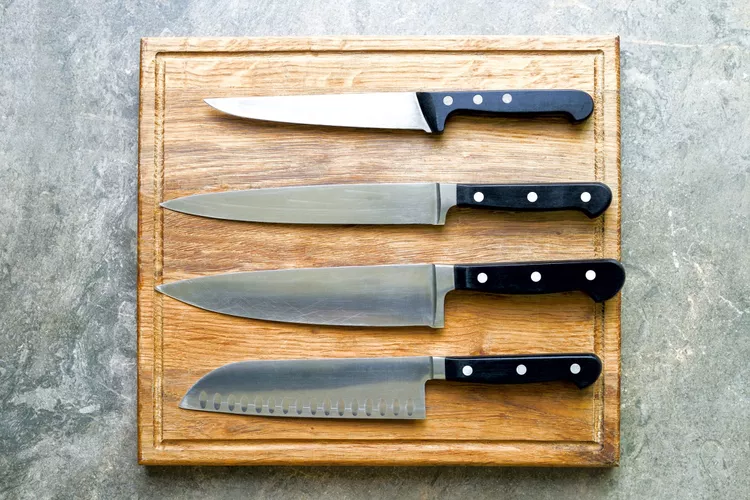Last updated on January 8th, 2024 at 12:46 pm
If you’re a chef or just admire a sharp blade, you’ve probably wondered, “What angle do you sharpen a knife?” A knife’s cutting capability, longevity, and efficacy depend on its sharpening angle.
This guide will cover knife sharpening angles and the best methods, strategies, and considerations for optimal outcomes. Let’s start with your favorite kitchen knife!
What Knife Sharpening Angles
Knife sharpening angles are how sharp the blade is honed. Acute angles can cause delicate edges that dull fast, whereas obtuse angles can reduce cutting effectiveness. Knife purpose, blade material, and user preference determine angle.
The Science Behind Knife Edge Angles
Understanding knife edges helps you understand sharpening angles. Honing a knife creates a V-shaped bevel on both sides, creating the cutting edge. The knife’s sharpness and durability depend on these bevels’ intersection.
Common Knife Sharpening Angles Explained

We’ll explain knife sharpening angles. Angle details:
15-20 degrees: Razors and delicate kitchen knives have this shallow angle. It’s sharp but fragile.
20-25 Degrees: Kitchen knives like this angle because it balances sharpness and endurance. It cuts well and is versatile.
25-30 Degrees: Cleavers and machetes use this angle for durability. It may affect cutting efficiency marginally.
30+ Degrees: Axes, hatchets, and other specialist tools use angles over 30 degrees. Durability trumps sharpness.
Sharpening Angle Recommendations for Different Knives

Knife type and use determine the best angle for sharpening. General sharpening angles for different knives:
Chef’s Knife: A chef’s knife is a multipurpose culinary tool. A 15–20-degree sharpening angle each side is ideal. This angle balances sharpness and durability.
Paring Knife: Smaller knives for peeling, trimming, and slicing tiny fruits and vegetables. Paring knives are sharpened at 15 degrees each side for precision and control.
Santoku Knife: Japanese-style santoku knives are used for slicing, dicing, and chopping. Santoku knives should be sharpened 12–15 degrees per side.
Serrated Knife: Serrated knives with teeth-like blades are perfect for cutting bread and tomatoes. These knives need special honing. To maintain the serrated edge, use a sharpening rod or serrated knife sharpener instead of honing each tooth.
Hunting or Survival Knife: These knives are used for camping, hunting, and bushcraft. Use determines these knives’ sharpening angle. For outdoor work, a sharpening angle of 20–25 degrees each side balances sharpness and durability.
Pocket Knife: Pocket knives can open parcels and cut ropes. Pocket knives should be sharpened at 15 to 20 degrees each side, depending on their design and application.
Tools and Techniques for Sharpening at the Right Angle

Tools and procedures are needed to sharpen perfectly. Popular methods:
Sharpening Stones: Whetstones sharpen knives. Different grits let you gradually sharpen the blade. A sharpening guide or muscle memory can keep the angle.
Guided Sharpening Systems: Guided sharpening methods guarantee consistent angles. These devices have angle guides and abrasive surfaces for exact sharpening.
Sharpening Jigs: Jigs help maintain a constant angle while sharpening. They secure the knife and direct the sharpening motion, making accurate results simpler.
Electric Sharpeners: Electric sharpeners are useful for touch-ups. Some models include changeable angle guides to modify the sharpening angle.
Professional Sharpening Services: Professional Sharpening Services: If you’re not sure how to sharpen, you can always hire a pro. These professionals can properly sharpen your knives.
The Importance of Consistency in Sharpening Angles
Sharpening angles requires constancy. Maintaining a constant angle across the blade keeps it sharp and prolongs knife life. Inconsistent angles can ruin the edge, cut, and blade.
Use a sharpening guide, jig, or muscle memory to stay consistent. Take your time, focus on the angle, and sharpen with steady pressure.
Tips for Maintaining and Testing Knife Edge Angles

Consider these edge angle maintenance and evaluation tips to keep your blades sharp and performing well:
Frequent Examination: Check your knife’s edge often for dullness or damage. Visually viewing the blade under adequate illumination can reveal abnormalities or chips.
Paper Assessment: You can test your knife’s sharpness by cutting paper. A sharp knife cuts paper cleanly.
Cutting Efficiency: When cooking, focus on cutting efficiency. A touch-up may be needed if cutting efficiency or effort decreases.
Honing: A honing rod or steel can help retain the knife’s edge between sharpenings. Honing restores sharpness.
Questions (FAQs)
For sensitive work, what knife angle is best?
Filleting fish and chopping vegetables require a steeper angle of 15-20 degrees. This angle cuts intricately.
Are there standard knife angles?
No knife angle fits all. Knife purpose, blade material, and user preference determine the best sharpening angle. Knives have optimum angles for specific operations.
Serrated knives: same angle?
Scalloped or wavy edges distinguish serrated knives. Traditional sharpening stones and guided systems are not advised for serrated blades. Instead, use a serrated knife sharpener or see an expert.
Benefits of a narrower sharpening angle?
Sharpening at 15-20 degrees improves precision and sharpness. It excels at delicate slicing, cutting, and handling. Narrower angles are less durable than larger angles.
Should I check and adjust the sharpness angle often?
After frequent usage or when cutting performance decreases, check your knife’s sharpening angle. Honing and touch-ups can prolong sharpenings.
Is a knife sharpenable without a guide?
With practice, you can sharpen a knife without a guide. Sharpening at a specific angle requires muscle memory and a constant hand motion. For novices, a sharpening guide or jig is advised for accuracy.
Conclusion
In conclusion, sharpening a knife at the right angle improves cutting performance and longevity. Knowing the appropriate knife sharpening angle can improve your cooking, whether you’re a chef or a home cook. When choosing a sharpening angle, consider the knife’s purpose,
blade material, and personal preferences. Maintaining razor-sharp edges makes slicing and dicing easy with the correct equipment, techniques, and consistency.
When you question, “What angle do you sharpen a knife?” consider this guide’s helpful tips. Sharpen away!
